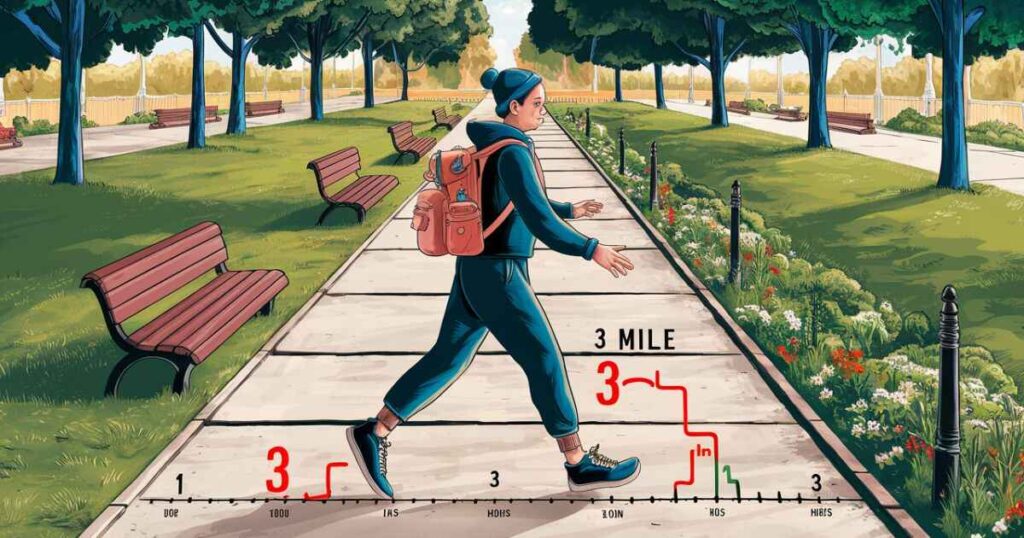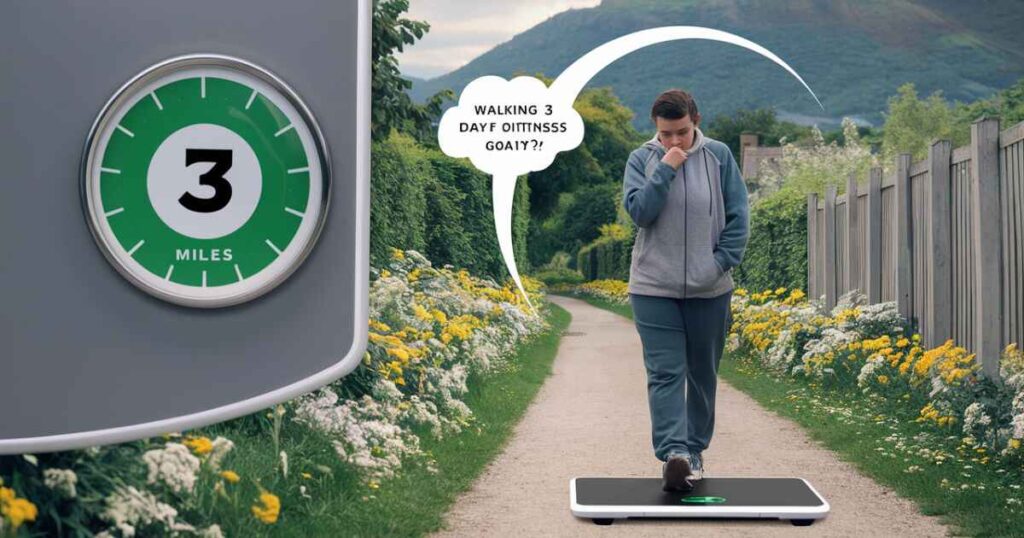Walking 3 miles is a popular fitness goal for many people. It’s a distance that takes about an hour at a moderate pace. This walk can be done outdoors or on a treadmill. It’s long enough to provide health benefits but short enough to fit into most schedules.
Imagine transforming your health with just one hour of your day. That’s the power of walking 3 miles. It’s a simple activity that anyone can do, anywhere. You don’t need fancy equipment or a gym membership. Just a pair of comfortable shoes and the will to move.
A daily 3-mile walk offers numerous benefits. It can improve your heart health and help you lose weight. It boosts your mood and energy levels. Walking can even reduce the risk of certain diseases. Best of all, it’s a low-impact exercise suitable for most people. So why not give it a try.
How Long Does It Take to Walk 3 Miles?

The time it takes to walk 3 miles can vary widely depending on several factors. Your average walking speed, fitness level, age, and even the terrain you’re walking on all play a role. For most people, walking 3 miles takes between 45 minutes to an hour. But don’t worry if you’re not quite there yet everyone starts somewhere!
Think of it this way: if you’re walking at a moderate pace of about 3 miles per hour, you’ll complete your 3-mile journey in roughly 60 minutes. That’s about the same time it takes to watch an episode of your favorite TV show. But instead of sitting on the couch, you’ll be giving your body a fantastic workout.
How far is 3 miles?
Three miles might not sound like much, but it’s a substantial distance when you’re on foot. To put it in perspective, 3 miles is equivalent to about 4.8 kilometers. If you’re a sports fan, think of it as 12 laps around a standard quarter-mile track. For city dwellers, it’s roughly the distance from the Empire State Building to Central Park in New York City.
Visualizing the distance can help motivate you to lace up those sneakers and hit the pavement. Imagine walking from your front door to a local landmark that’s 3 miles away. You might be surprised at how much ground you can cover on foot. And remember, every step you take is a step towards better health.
Average time to walk 3 miles for women by age
These figures are just averages, and many women may find they can walk faster or slower depending on their individual fitness levels. The key is to find a pace that challenges you without overexerting yourself. Remember, consistency is more important than speed when it comes to reaping the health benefits of walking.
Age plays a significant role in walking pace by age, especially for women. Here’s a breakdown of the average time it takes women of different age groups to walk 3 miles:
| Age Group | Average Time (Minutes) | Average Pace (Miles Per Hour) |
| 20-29 | 45-50 | 3.6 – 4.0 |
| 30-39 | 45-50 | 3.6 – 4.0 |
| 40-49 | 50-55 | 3.2 – 3.6 |
| 50-59 | 55-60 | 2.9 – 3.2 |
| 60+ | 60-70+ | 2.4 – 2.9 |
Average time to walk 3 miles for men by age

As with women, these are just averages. Many men may find they walk faster or slower depending on their fitness level and other factors. The important thing is to focus on your personal progress rather than comparing yourself to others. Every step you take is a step towards better health, regardless of your speed.
Men typically have a slightly faster walking pace by age compared to women, primarily due to differences in average height and muscle mass. Here’s a look at the average time it takes men of different age groups to walk 3 miles:
| Age Group | Average Time (Minutes) | Average Pace (Miles Per Hour) |
| 20-29 | 43-48 | 3.7 – 4.2 |
| 30-39 | 45-50 | 3.6 – 4.0 |
| 40-49 | 48-53 | 3.5 – 3.8 |
| 50-59 | 53-58 | 3.2 – 3.5 |
| 60+ | 58-68+ | 2.6 – 3.2 |
Why is walking good?
Walking is often underrated as a form of exercise, but it’s one of the most accessible and beneficial activities you can do for your health. Let’s explore some of the remarkable walking benefits that make this simple activity so powerful.
1. Improves heart health
Walking is a fantastic cardiovascular exercise that gets your heart pumping and blood flowing. Regular walks can help lower your blood pressure, reduce bad cholesterol levels, and decrease your risk of heart disease. In fact, studies have shown that walking for just 30 minutes a day can reduce the risk of coronary heart disease by 19%. It’s like giving your heart a daily tune-up!
2. Help in losing weight
If you’re looking to shed a few pounds, walking for weight loss can be an effective strategy. A brisk 3-mile walk can burn anywhere from 300 to 400 calories, depending on your weight and pace. That’s equivalent to a small meal! By incorporating daily walks into your routine, you can create a calorie deficit that leads to gradual, sustainable weight loss.
3. Reduces the risk of dangerous diseases
Walking isn’t just good for your heart – it’s a full-body health booster. Regular walks can help reduce your risk of type 2 diabetes, certain cancers, and even stroke. It’s like a daily dose of preventive medicine, all wrapped up in a pleasant outdoor activity. Who knew that something as simple as putting one foot in front of the other could have such profound health impacts?
4. Boost immunity
In these health-conscious times, boosting your immune system is more important than ever. Regular walking can help strengthen your immune system, making your body more resilient against common illnesses. It’s like giving your internal defense system a daily workout, preparing it to fend off invaders more effectively.
5. Improves brain health
Walking isn’t just good for your body – it’s a brain booster too! Regular walks can improve cognitive function, enhance memory, and even reduce the risk of cognitive decline as you age. It’s like giving your brain a refreshing shower, washing away the mental cobwebs and leaving you feeling sharper and more focused.
6. Creative Thinking
Have you ever noticed how some of your best ideas come to you when you’re out for a walk? There’s science behind that! Walking, especially in nature, has been shown to boost creative thinking. Many famous thinkers and innovators, from Steve Jobs to Aristotle, were known for their walking habits.
7. Increases energy
It might seem counterintuitive, but expending energy through walking can actually boost your overall energy levels. Regular walks can improve your circulation, increase oxygen flow throughout your body, and stimulate the release of energy-boosting endorphins. It’s like giving yourself a natural energy drink, without the jitters or crashes that come with caffeine.
8. Strengthen bones and muscles
Walking is a weight-bearing exercise, which means it’s great for strengthening your bones and muscles. Regular walks can help prevent osteoporosis, strengthen your leg and core muscles, and improve your overall balance and coordination. It’s like giving your skeletal system a gentle but effective workout, keeping you strong and stable as you age.
9. Improves mood and mental health
Last but certainly not least, walking can work wonders for your mood and mental health. The combination of physical activity, fresh air, and often, a change of scenery can help reduce stress, alleviate symptoms of anxiety and depression, and improve overall mental well-being. It’s like giving your mind a mini-vacation, helping you return to your day feeling refreshed and more positive.
Read More: How Long Does It Take To Walk 2 Miles? Improve Your Time & Stay Active
Is walking 3 miles in 40 minutes good?

Walking 3 miles in 40 minutes is indeed an impressive feat! This pace translates to a speed of 4.5 miles per hour, which is considered a brisk walking pace. It’s faster than the average walking speed and indicates a good level of fitness. If you can maintain this pace, you’re not just walking you’re power walking!
At this speed, you’re giving your body a solid cardiovascular workout. You’re likely breathing harder, your heart rate is elevated, and you’re burning a significant number of calories. This pace is excellent for improving your overall fitness, boosting your metabolism, and enhancing your endurance.
Is walking 3 miles in 50 minutes good?
Walking 3 miles in 50 minutes equates to a pace of 3.6 miles per hour, which is still considered a moderately brisk pace. This speed is perfect for those who want to get a good workout without pushing themselves too hard. It’s a sustainable pace that you can maintain for longer distances, making it ideal for building endurance and burning calories.
At this pace, you’re still reaping plenty of health benefits. You’re elevating your heart rate, improving your cardiovascular fitness, and burning a substantial number of calories. Plus, this pace allows you to maintain a conversation while walking, making it perfect for social walks with friends or family. It’s a great balance between exercise and enjoyment.
How many steps are in a 3 mile walk?
The number of steps per mile walking can vary depending on your stride length, which is influenced by factors like height and walking speed. On average, there are about 2,000 steps in a mile. So, for a 3-mile walk, you’re looking at approximately 6,000 steps.
Here’s a quick breakdown:
- Average steps per mile: 2,000
- Steps in a 3-mile walk: 6,000
- Steps for shorter individuals: 6,500-7,000
- Steps for taller individuals: 5,500-6,000
How many calories do you burn walking 3 miles?
The number of calories burned walking 3 miles can vary based on factors like your weight, walking speed, and the terrain. However, we can provide some general estimates to give you an idea of the calorie-burning potential of your 3-mile walks.
Here’s a rough breakdown of calories burned walking 3 miles at a moderate pace (3 mph):
- 130-pound person: About 224 calories
- 155-pound person: About 267 calories
- 180-pound person: About 311 calories
- 205-pound person: About 354 calories
If you increase your pace to a brisk 4 mph, you’ll burn even more:
- 130-pound person: About 295 calories
- 155-pound person: About 352 calories
- 180-pound person: About 409 calories
- 205-pound person: About 465 calories
Is walking 3 miles a day enough?

Walking 3 miles a day is an excellent foundation for a healthy lifestyle. It meets the Centers for Disease Control and Prevention (CDC) recommendations for adults to get at least 150 minutes of moderate-intensity aerobic activity per week. A daily 3-mile walk at a moderate pace would give you about 300 minutes of exercise per week, doubling the minimum recommendation!
For many people, especially those just starting a fitness journey or those with busy schedules, a daily 3-mile walk can be more than enough to see significant health benefits. It can help with weight management, improve cardiovascular health, boost mood, and reduce the risk of various chronic diseases.
“Enough” depends on your personal health goals. If you’re looking to lose a significant amount of weight or train for a specific athletic event, you might need to supplement your walks with other forms of exercise or increase your walking distance or intensity. Always consult with a healthcare provider or fitness professional to determine the best exercise plan for your individual needs.
Plan your walking routine
Creating a solid walking routine is key to making the most of your 3-mile walks. Here’s how you can plan an effective routine that fits into your lifestyle and helps you achieve your fitness goals.
1. Set Your Goals
Start by defining what you want to achieve with your walking routine. Are you aiming to improve your cardiovascular health, lose weight, or simply establish a consistent exercise habit? Having clear goals will help you stay motivated and track your progress. For example, you might set a goal to walk 3 miles every day for a month, or to gradually increase your walking speed over time.
2. Choose a Walking Route
Selecting the right walking route can make your daily walks more enjoyable and sustainable. Look for paths in your neighborhood that are safe, well-lit, and ideally have some scenic elements. You might choose a local park, a nearby trail, or even a different route through your neighborhood each day to keep things interesting.
3. Warm-Up
Never underestimate the importance of a good warm-up. Before you start your 3-mile walk, take 5-10 minutes to prepare your body. This could include gentle stretches, ankle rolls, or simply walking at a slower pace to gradually increase your heart rate. A proper warm-up can help prevent injuries and make your walk more comfortable.
4. Start slowly
If you’re new to regular walking or returning after a break, it’s crucial to start slowly and gradually build up your endurance. Begin with shorter walks at a comfortable pace, and slowly increase your distance and speed over time. This approach helps prevent burnout and reduces the risk of injury. Remember, consistency is more important than intensity when you’re starting out.
5. Include Intervals
Once you’ve established a comfortable walking routine, consider incorporating intervals to boost your fitness and calorie burn. This could involve alternating between periods of brisk walking and moderate-paced walking. For example, you might walk at a challenging pace for 2 minutes, then recover with 2 minutes of easier walking, repeating this pattern throughout your walk.
6. Cool Down
Just as important as warming up is cooling down after your walk. Spend the last 5-10 minutes of your walk gradually decreasing your pace. Once you’ve finished, take some time to stretch your muscles, focusing on your legs, hips, and lower back. This helps prevent muscle stiffness and aids in recovery.
7. Establish a Schedule
Consistency is key when it comes to reaping the benefits of walking. Try to establish a regular walking schedule that fits into your daily routine. This might mean walking first thing in the morning, during your lunch break, or in the evening after dinner. The best time to walk is the time that you can consistently stick to.
8. Track Your Progress
Monitoring your progress can be a great motivator. Consider using a fitness tracker, smartphone app, or even a simple notebook to record your walks. Track metrics like distance, time, pace, and how you feel after each walk. Seeing your improvement over time can be incredibly rewarding and help you stay committed to your walking routine.
9. Listen to Your Body
While consistency is important, it’s equally crucial to listen to your body. If you’re feeling excessively tired or experiencing pain, it’s okay to take a rest day or reduce your walking intensity. Pay attention to signs of overexertion like persistent muscle soreness, fatigue, or decreased performance. Remember, rest and recovery are important parts of any fitness routine.
Read More: Unlock Wealth with Money6x Real Estate: Top Investment Tips for 2024
Safety Tips
While walking is generally a safe activity, it’s important to take some precautions to ensure your safety, especially if you’re walking outdoors. Here are some key safety tips to keep in mind:
- Stay visible: If you’re walking early in the morning or late in the evening, wear bright or reflective clothing. Consider carrying a flashlight or wearing a headlamp to make yourself more visible to drivers and cyclists.
- Be aware of your surroundings: Stay alert and pay attention to what’s going on around you. If you’re listening to music or podcasts, keep the volume low enough that you can still hear ambient sounds.
- Choose safe routes: Stick to well-lit, populated areas when possible. If you’re walking in a new area, research safe routes beforehand.
- Carry identification: Always carry some form of ID and emergency contact information with you.
- Let someone know: If you’re going for a long walk or exploring a new route, let a friend or family member know your plans and expected return time.
- Stay hydrated: Bring water with you, especially on longer walks or in warm weather.
- Dress appropriately: Wear comfortable, supportive shoes and weather-appropriate clothing.
- Follow traffic rules: Use sidewalks when available, face traffic when walking on the road, and obey all traffic signals.
- Be prepared for emergencies: Consider carrying a basic first aid kit and a fully charged cell phone.
- Trust your instincts: If a situation or area doesn’t feel safe, trust your gut and change your route or return home.
Frequently Asked Questions
How long does it take to walk 3 miles?
On average, it takes about 45-60 minutes to walk 3 miles at a moderate pace. However, this can vary based on your walking speed, fitness level, and the terrain.
What is the average walking speed for a 3-mile walk?
The average walking speed is about 3-4 miles per hour. At this pace, a 3-mile walk would take 45-60 minutes.
What is a brisk pace for walking 3 miles?
A brisk pace for walking is generally considered to be about 4 miles per hour. At this speed, you could complete 3 miles in about 45 minutes.
What are the health benefits of walking 3 miles a day?
Walking 3 miles a day can improve cardiovascular health, aid in weight management, boost mood, strengthen bones and muscles, reduce the risk of chronic diseases, and improve overall fitness and well-being.
How many minutes does it take to walk 3 miles on a treadmill?
On a treadmill, walking 3 miles typically takes about the same time as walking outdoors – around 45-60 minutes at a moderate pace. However, you can adjust the speed and incline on a treadmill to make your walk more challenging or easier as needed.
Conclusion
Walking 3 miles a day is a simple yet powerful way to boost your health and well-being. Whether it takes you 40 minutes or an hour, every step counts towards a healthier you. From improving heart health to sparking creativity, the benefits are numerous and far-reaching.
Consistency is key. Start where you are, set achievable goals, and gradually build your endurance. With time, your daily 3-mile walk will become a cherished habit, bringing a host of health benefits and a sense of accomplishment. So lace up those shoes and take that first step today – your body and mind will thank you.

